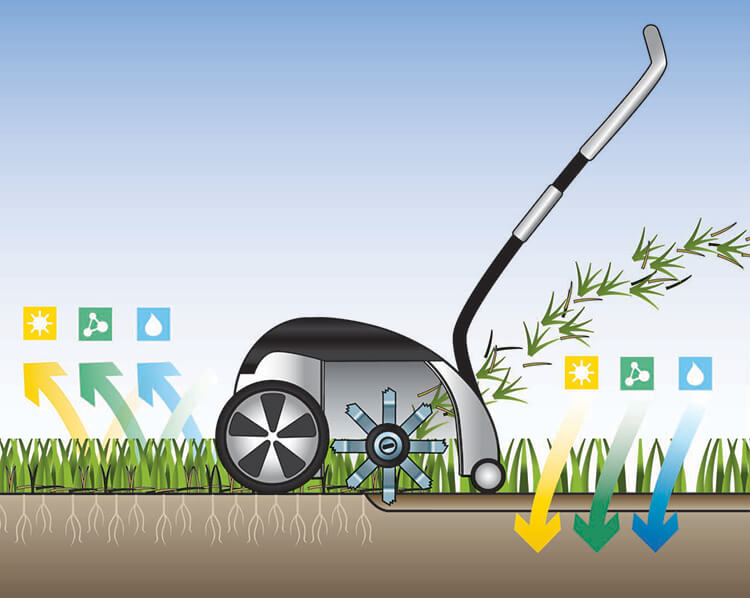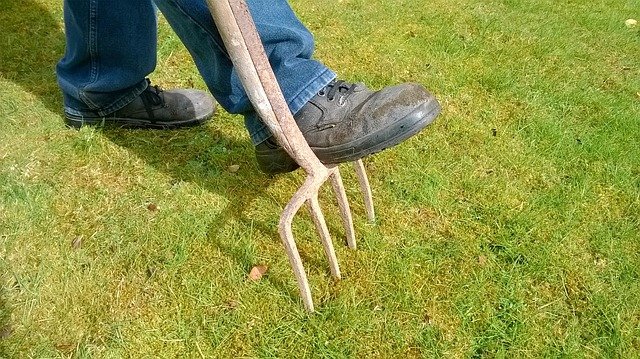Contents
Why scarify your lawn?
You can determine if you need to scarify your lawn with a simple test. Run a small rake or cultivator over the grass without pushing it down. If old mowing residue and pieces of moss are still clinging to the tines, it’s time to scarify the lawn.
Large amounts of weeds in the lawn are also a sure sign that the grass needs to be scarified, as the grass blades are visibly impeded in their growth.
One reason may be a lack of nutrients. But a thick layer of thatch can also prevent the supply of oxygen to the grass. This is where scarification comes in.
How does a scarifier work?

With its small blades, a scarifier cuts into the soil to remove moss and thatch.
Scarifiers have a horizontal shaft with rigid or rotating blades at relatively short intervals. The motor drives the shaft. The knives move and slash the ground cover over a few millimeters. Moss and felt are also removed.
What is important when scarifying?
Before scarifying your lawn, make sure it is completely dry. Set your scarifier at the right height. The blades should not go deeper than 3 cm into the grass. The Bosch UniversalVerticut 1100 makes it very easy to adjust the height.
Run the scarifier over the entire lawn as evenly as possible, first lengthwise and then widthwise. When turning, press down on the guide rails to prevent the blades from leaving deep marks.
Which scarifier is right for you?

A scarifier aerates your lawn, so it can flourish better.
A thermal dethatching machine is especially recommended for very large yards, so you are not dependent on a power outlet and don’t have to worry about the cord. Thermal scarifiers are also often heavier than their electric counterparts. This means they penetrate deeper into the ground cover.
An electric scarifier, on the other hand, is easier to maneuver. It is suitable for smaller, easily accessible areas. You do have to be careful with the power cord, but since you won’t be using the machine more than twice a year, this is not a big problem. If the electric scarifier is too light, you can add a small bag of sand to make it heavier.
Manual scarifiers do not require electricity or gasoline, but they do require a lot of elbow grease. They are, however, ideal for very small areas or isolated, muffled areas.
When to scarify your lawn?
The best time to scarify your lawn is from April to September. If you want to use your lawn a lot in the summer, you may want to scarify in the spring or late summer. Scarified grass needs a few weeks to recover from this maintenance. Take care of it during this recovery period.
Start your lawn maintenance with a fertilization in spring. As soon as the daffodils bloom, the grass will also start to grow again. So you can start fertilizing it. And don’t forget to start mowing again! You can do this yourself, or you can have a robot mower do it for you, which will mow your lawn to the desired height by itself.
Usually wait about two weeks after fertilization before mowing again. Mow the lawn to 2 cm high, or let your robot mower do the job. The ideal time for scarification has now arrived. The grass has been well fed and will take the scarification particularly well.
Don’t wait too long to do it; it’s often already a very hot and dry month. If you scarify your lawn at this time, don’t forget to water it abundantly afterwards to quickly close up the plant cover.
Scarifying the lawn: how to do it :
Scarifying is not rocket science. These tips will make it much easier:
- Scarify only a completely dry lawn.
- Set the height correctly. The knives should sink into the grass by a maximum of 3 cm.
- Mow the lawn to a height of 2 cm.
- Then scarify the entire lawn. Do not stay in one place for long, move the machine quickly over the lawn.
- Move the scarifier first lengthwise and then widthwise.
- When changing direction, press down on the guide rails to lift the blades and prevent them from injuring the grass.
- Sow grass seed in the bare spots immediately after scarifying.
- Rip the grass felt from the lawn surface.
- If the grass is growing on heavy soil, spread a layer of masonry sand about 2 cm thick after scarification to improve soil aeration.
Why aerate the lawn?
In addition to scarification, you should occasionally run a soil aerator over your lawn. If the roots of the grass receive little oxygen, it will hinder their development. Your lawn will suffer and will no longer have its beautiful shimmering appearance. A poorly aerated lawn is also vulnerable to moss.
What happens when you aerate the lawn?

Aerating the lawn
Aerate your lawn with a fork. This will allow the roots to get a better supply of oxygen. ©MSG/Martin Staffler
When you aerate your lawn, you loosen the soil underneath the lawn. This allows the grass roots to get a better supply of oxygen. Water can also penetrate the soil better. The grass starts to grow better, becomes denser and looks healthier again.
Lawns that are heavily used should be aerated every one to two months. If you use the lawn infrequently, if at all, you can afford to aerate it only once a year.
When you aerate the lawn, you loosen the soil underneath the lawn. This allows the grass roots to get a better supply of oxygen. Water can also penetrate the soil better. The grass starts to grow better, becomes denser and looks healthier again.
Lawns that are heavily used should be aerated every one to two months. If you use the lawn infrequently, if at all, you can afford to aerate it only once a year.
Which soils should be aerated?
In principle, all soils can be affected by oxygen deficiency. However, the problem occurs very often with clay soils. The reason for this is the fine structure of the soil. The stresses compress the surface, so that the roots are hardly supplied with air.
It is therefore a good idea to aerate the soil. To achieve optimal results, combine aeration with other measures. For example, consider adding sand from time to time to a very clayey soil to loosen the structure.
When and how to aerate the lawn?
The best time to aerate the lawn is from late March to early October. Choose a time when the soil is moist but not wet.
How to aerate the lawn?
There are three ways to aerate your lawn:
- the spade fork
- the aeration fork
- the soil aerator
If your soil is only heavily compacted in places, you can use a spade fork. Push the tines all the way into the soil in the affected areas and shake the spade fork to enlarge the holes a little. This creates channels for water and oxygen to enter the soil. Then fill these holes with fine sand.
An aeration fork doesn’t just create holes in the soil: its hollow tines pull up the soil from the dug holes, allowing plenty of air and water to enter the soil. Again, fill the resulting channels with fine sand.
While you can aerate your lawn by hand, the easiest way is still to use a lawn aerator. With the Bosch UniversalRaker 900, you can get fresh air into your lawn in a particularly quick and convenient way.
Lawn aerators are much more gentle on the grass than scarifiers. This is an advantage. But they also remove less moss from the lawn, which is a disadvantage. Ideally, you want to combine the two.
Sanding the lawn
To keep your soil supple over time and allow water and oxygen to reach the roots, it is not enough to scarify and aerate the lawn, it must also be sanded in the spring. Spread about 5 L of play or masonry sand per square meter of lawn. Level the sand with a broom or rake.
Rainwater will help the sand to sink further and further into the air holes created, allowing the water and air channels to remain open for a long time.









